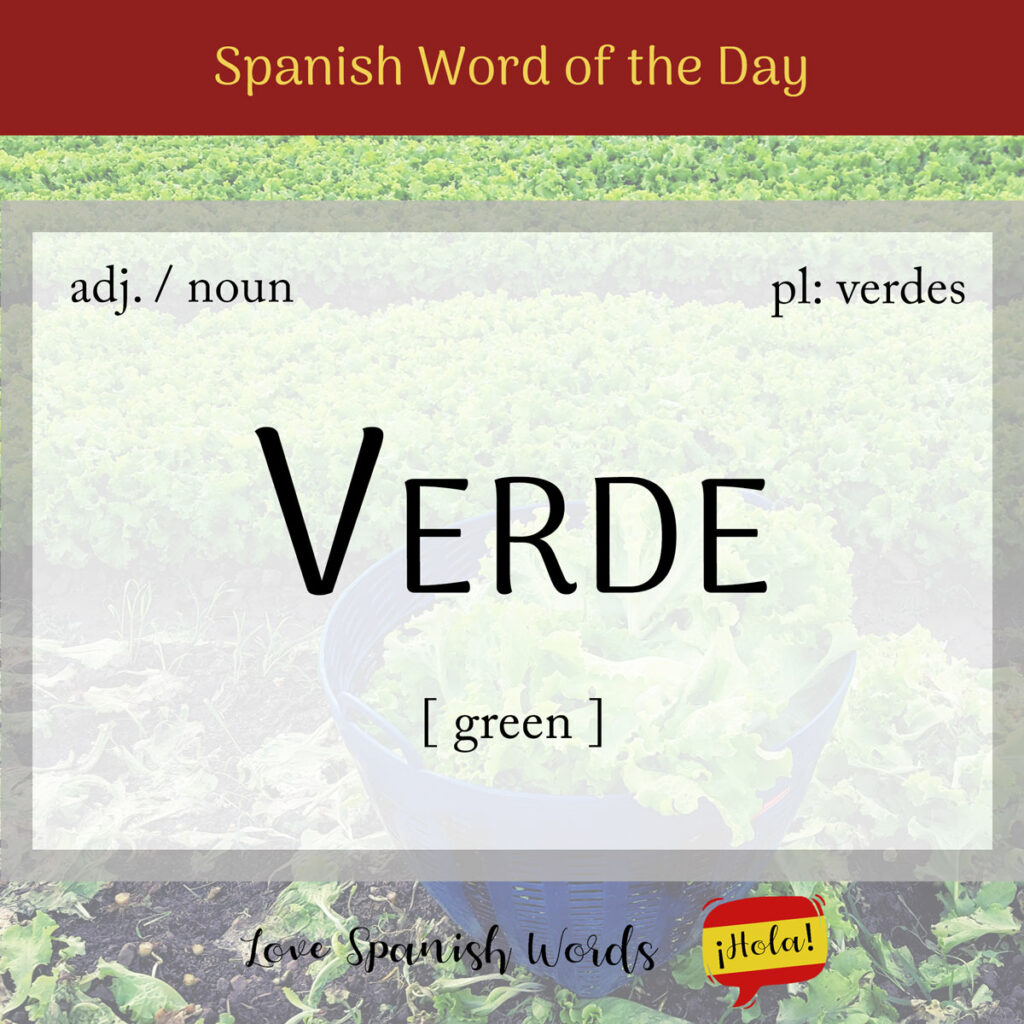The colour green is all around us in nature, from trees to plants and the fruits and vegetables we eat. Verde is the Spanish word for green. It originates from the Latin word viridis, which also means green.
Latin American Pronunciation
European Pronunciation

When used as an adjective, verde agrees in gender and number with the noun it modifies. Its plural form is verdes. For example, green leaves becomes hojas verdes, agreeing in gender and number.
Verde is also used as a masculine noun when referring to the colour itself or when describing something painted or decorated in that colour.
- El verde es uno de los colores de la bandera de México. = Green is one of the colours of the Mexican flag.
- Me gusta el verde porque es el color de la naturaleza. = I like green because it’s the colour of nature.
El verde es el cuarto color del arcoíris.
Green is the fourth colour of the rainbow.
There are many different classes and variants of the colour green as listed below:
- verde esmeralda = emerald green
- verde oliva = olive green
- verde lima = lime green
- verde menta = mint green
- verde pino = pine green
- verde jade = jade green
- verde bosque = forest green
- verde agua = cyan
- verde militar = military green
Figurative uses of the word green include the following:
- los verdes = money (green bills)
- movimiento verde = green movement
- dieta verde = green diet
- verde afortunado = lucky green
- estilo de vida verde = green lifestyle
- energía verde = green energy
- certificado verde = green-certified
Figuratively, verde has many uses. It is often associated with freshness, youth, and inexperience. An idiomatic expression is estar verde (to be green). It refers to someone who is immature or inexperienced either in ability or a situation. It also refers to fruit and vegetables being fresh and not mature enough to eat. For example:
- Juan está verde en las relaciones, pero aprenderá rápido. = Juan is green in relationships, but he will learn quickly.
- Es un poco verde cuando se trata de hablar en público. = He’s a bit green when it comes to public speaking.
- El mercado vende una variedad de vegetales verdes. = The market sells a variety of green vegetables. (meaning new or fresh, not the colour)
Los aguacates todavía están verdes. No están listos para comer.
The avocados are still green. They aren’t ready to eat.
Green is also often associated with naturaleza (nature). We see it used figuratively to talk about the environment (medio ambiente) and sostenibilidad (sustainability). When someone talks about an espacio verde (green space), they are referring to parks and other natural areas within urban settings.
When someone practises an estilo de vida verde (green lifestyle), they refer to the practice of sustainability such as recycling, vegetarianism, or other green practices.
- Es importante proteger las áreas verdes de la ciudad. = It is important to protect the city’s green areas.
- Vivo un estilo de vida verde (ecológico) conduciendo un coche híbrido. = I live a green lifestyle by driving a hybrid car.
Related to the theme of nature are salud (health) and bienestar (wellness). Green is associated with nature, specifically fruits and vegetables which provide health and wellness.
- Es bueno incluir vegetales verdes en la dieta diaria. = It is good to include green vegetables in your daily diet.
- Es bueno salir a lo verde para mejorar el ánimo. = It’s good to go out into nature (the green) to improve your mood.
Intento llevar una vida verde por mi salud.
I try to lead a green lifestyle for my health.
Green is also often used to refer to US dollars informally and colloquially. For example:
- Necesito más verdes para comprar una casa. = I need more money (greens) to buy a house.
- ¿Cuántos verdes te debo? = How much money do I owe you? (How many greens/bills do I owe you?)
Because green is associated with money, it’s considered a lucky colour. We refer to it as verde afortunado (lucky green).

Fun Fact:
The color green plays a significant role in the Irish celebration of St. Patrick’s Day. Symbolizing wealth and fortune, the day features images of lucky pots of gold. To embrace the spirit of this holiday, people wear green, which is believed to attract prosperity, good fortune, and suerte (luck).
We also perceive the green trébol de cuatro hojas (four-leaf clover) as being lucky. It’s also considered a symbol of luck in Irish culture and is associated with St. Patrick’s Day.

Spanish idioms featuring ‘verde’
Verde in Spanish appears in various idiomatic expressions that enrich the everyday language. Let’s see some of them below:
Estar verde por fuera, podrido por dentro
Literal translation: to be green on the outside, rotten on the inside
English meaning: to be someone or something that appears good or healthy superficially but is actually bad or corrupt
Estar verde de envidia
Literal translation: to be green with envy
English meaning: to be jealous/envious of someone
Dar luz verde
Literal translation: to give the green light
English meaning: to give permission or approval
Estar verde como una lechuga
Literal translation: to be green like a lettuce
English meaning: to be very green, used to describe someone who looks pale or sick
Poner verde a alguien
Literal translation: to make someone get green
English meaning: to speak ill of someone/badmouthing
Tener verde esperanza
Literal translation: to have green hope
English meaning: to have optimism or hope for the future

